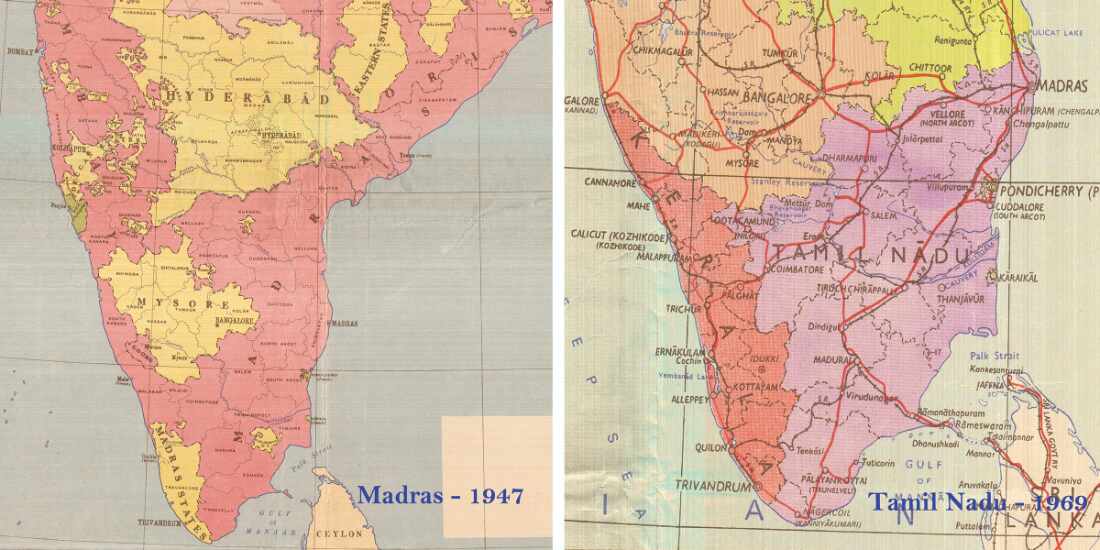From Madras to Tamil Nadu - I
The transformation of Madras to Tamil Nadu was based on the realisation and assertion of the Tamil ethnic and linguistic pride

When India became independent in 1947, Madras retained its status as a province under the Indian Dominion. The highlight of this year was the enactment of laws allowing universal access to all the temples, and the abolition of the Devadasi tradition. When Indian became a Republic in 1950, it was called the State of Madras. It included the whole of present-day Tamil Nadu (except Kanyakumari district), Coastal Andhra, Rayalaseema, the Malabar region of North and Central Kerala, and Bellary, South Canara. Coastal Andhra and Rayalaseema were separated to form Andhra State in 1953, while South Canara and Bellary districts were merged with Mysore State, and Malabar District with the State of Travancore-Cochin to form Kerala, and in 1956 the State's boundaries were re-organised following linguistic lines.
Madras was retained as the name even after the linguistic reorganisation of states in 1956 and got the new name of Tamil Nadu only in January 1969, when CN Annadurai was the Chief Minister. It should, however, be placed on record that the initial proposal for changing the name of the state had been mooted by the Congress Chief Minister K Kamaraj, but he never took it to its logical end. Incidentally, Kamaraj had also proposed Madurai as the capital of the new state.
The renaming of the state as Tamil Nadu actually marked the assertion of Tamil ethnic and linguistic pride and assertion. In a way, it also signalled the end of the demand for a separate Dravidistan, a movement which was spearheaded by the Justice Party. This party had come to power in Madras Presidency after the Montagu-Chelmsford Reforms in 1919, aided by the fact that the Congress had boycotted the elections on account of the non-cooperation movement.
The party was established in 1917 and was led mainly by the Chettiar Community and the Nadars of Virudhunagar. However, under the leadership of the legendary Periyar, the party resolved that Dravidistan should be a separate state, loyal to the British Raj and "directly under the Secretary of State for India." This demand soon became the fundamental issue of the Justice movement. After visiting the Soviet Union, Periyar advised that "members of the Kazhagam should wear black shirts whenever possible, as a symbol of the present downtrodden condition of the Dravidians." The objective of the DK was proclaimed to be the achievement of a sovereign independent Dravidian Republic, which would be federal, with four units corresponding to the linguistic divisions (Madras, Kerala, Mysore, and Andhra), each having residuary powers and autonomy of internal administration.
However as the Dravidian parties decided to boycott the General elections of 1952, the Congress emerged as the single largest party even though the CPI led coalition was in a better position to form the government. Nevertheless, C Rajagopalachari was 'nominated' by the then Governor to the Legislative Council and took office as the Chief Minister state, a move which was both unethical and controversial. Dr PC Alexander, himself a former Tamil Nadu and Maharashtra Governor, referred to it as a most conspicuous case of constitutional impropriety
During this time, freedom fighter Potti Sriramulu called for a separate state for Telugu speaking districts, to be named Andhra, and went on an unconditional fast until his goal was achieved. It was alleged that Rajaji failed to intervene, either to break the fast or to provide medical help for Sriramulu, even though the fast had continued for over fifty days.
Rajaji also removed controls on food grains and introduced a new education policy based on family vocation. It was severely opposed by Dravida Kazhagam and DMK as casteist and dubbed Kula Kalvi Thittam (Hereditary Education Policy) this policy was under attack from within the Congress as well as outside it. In fact, he had to be replaced by the Congress, and Kamaraj took over as the CM in 1954.
One of the first political acts of Kamaraj during his tenure as Chief Minister was to widen representation of the rising non-Brahmins in the cabinet but retained both C Subramanian and M Bhakthavatsalam, who had contested his leadership. In a move to counter Tamil cultural politics espoused by the DMK, Kamaraj made conscious attempts to partake in the linguistic-cultural matters and offered ministerial positions to parties like Tamil Nadu Toilers Party.
He took steps towards introducing Tamil as a medium of instruction in schools and colleges. The usage of Tamil in the courts received encouragement and in February 1962, he moved a resolution in the legislative assembly for changing the name of Madras to 'Tamil Nadu' for 'intrastate communication'.
...to be continued
The writer is the Director of LBSNAA and Honorary Curator, Valley of Words: Literature and Arts Festival, Dehradun



